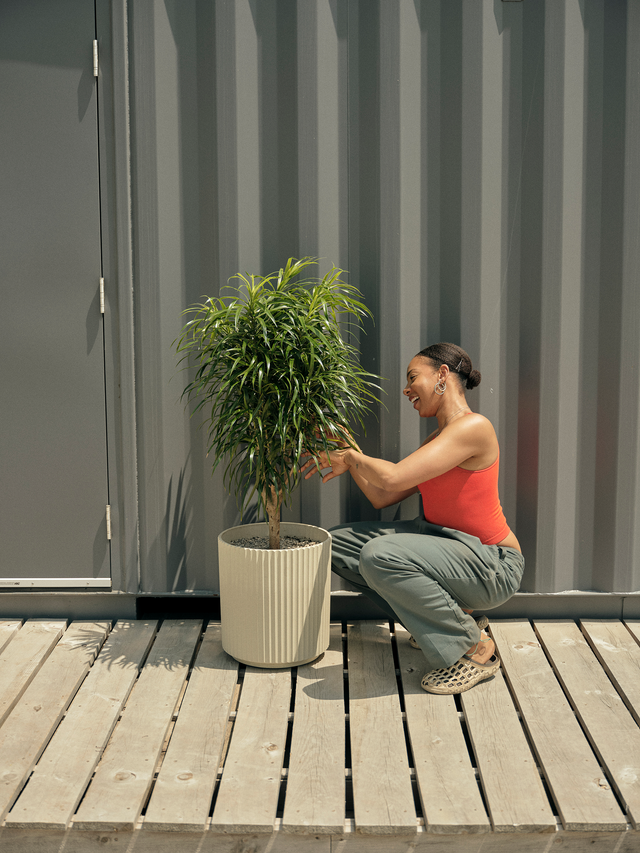diy tropical arrangement
Designer Spotlight:
Shada Morris,
Garden Designer
Founder of Forè,
@fore.garden
Say no to boring easy houseplants and yes to tropical arrangements. In this article, Garden Designer and Founder of Forè, Shada Morris explores the possibilities of container gardening, and why some planters are better than others.
what you need:
container:
Mason Demi 16 Planter
potting mixture:
Moisture control potting mix that's peat-based
Worm castings
Sea kelp meal
plant:
Dracaena 'Anita' Stump
Tell us about your arrangement. You used the Demi 16 Planter in sandstone, our newest planter and shade. Tell us, why did you choose this planter?
For sure. I actually love this planter. I ordered extras. It looks so beautiful. When it came here, I was like “oh wow, this is great, this is really nice”. I wasn't expecting a pot that is, I guess, partly plastic*. To have such a beautiful finish. It reads like fiberglass or concrete. You can use it indoors, you can use it outdoors, it's lightweight, but it's sturdy. And there's already drainage holes so you don't have to screw or drill in extras. It's just a nice modern but clean planter that I can see working in a lot of different spaces.
*The Mason Series Planters are made from a patented stone plastic composite. They have the look of stone and the durability of plastic. 
What kind of plants would work best for this container?
This is a planter that can work for both perennials and indoor plants. I would love to use tropicals in this one because there's something about that, that feels very statement like. I'd love to use an interesting indoor plant that has a little bit of structure some height to it, because the pot itself can handle that and the ridges really give it a nice finish that allows for the plant itself to shine.
follow these steps
step 1:
Start by adding a lightweight potting mix. This could be a pre-packaged soil blend or be one that you make on your own as long as you have a healthy amount of perlite or vermiculite. Usually, they look like these little white balls that are found in your potting mix. If your soil has a good ratio of the two in it, then you know that you're going to have a good amount of airflow in the pot itself, so you are not going to get any root rot.

step 2:
Now that we've lined the bottom of our pot with our soil, let's bring in our Dracaena ‘Anita’ Stump. This is a really low maintenance plant, and one I love to work with. This is a big plant, so when you're taking a plant of this size out of its pot, make sure you're holding onto the base. Just gently wiggle it out of its nursery pot, which is the black plastic pot it came in. 

step 3:
Now you’re going to gently tease out your roots. Just so that the plant’s roots will be able to spread freely into this new pot that we're putting it in.
step 4:
Once you find the position that you like, you are going to start to back fill, which is adding in more potting soil around to stabilize the plant before you start adding in nutrients and some more potting soil.
Reminder that you can always use the same soil that the plant came in. All plants, especially ones that you're purchasing from a nursery, or a garden center will have spent their entire life in that black pot. So, the plant is really used to the soil, fertilizer, and the feed that's already in the pot.
step 5:
Next, I like to add in a little extra food and things that will help your new plant get used to its new home. As always, worm castings. I like to sprinkle in my worm castings and really work them into the soil, especially around the roots, so that the plant can get all that good stuff right away. 
Worm castings contain a lot of beneficial ingredients and bacteria that indoor plants and outdoor plants both love. This is going to help with any transplant shock and any stress the plant might experience with the transfer. It also helps with pests. By having a really strong plant (properly nourished), it's going to be more resilient towards the common indoor plant pests that we usually get, like Scales and Mealybugs.
step 6:
We’re going to add in one more thing, just a little shot of sea kelp. Just a light sprinkle in there to add more nutrients for the plant.
Sea kelp is an easy and natural fertilizer, which means it's not going to burn the roots. A light sprinkle will slowly feed the plant over months. Sometimes when you use a liquid fertilizer, the plant takes it up right away, by using a dehydrated and granular fertilizer it stays in the soil much longer, and the plant will use it for a longer period of time.
step 7:
Remember you’ll always want to leave a little bit of a gap at the top of your pot, ideally like an inch if you can, so that when you do water the plant, there's no water that's going to fall over the sides.

And then in the future, when you start to notice that your soil level is going down a little bit, which happens naturally, soil compaction, watering, just changes in its environment, you can add on some more worm castings and fresh potting soil, and that will feed your plant every time you water it.
Photography by: Mike Tjioe
Art Direction by: Clare Chow







0 Comments
There are no comments for this article. Be the first one to leave a message!